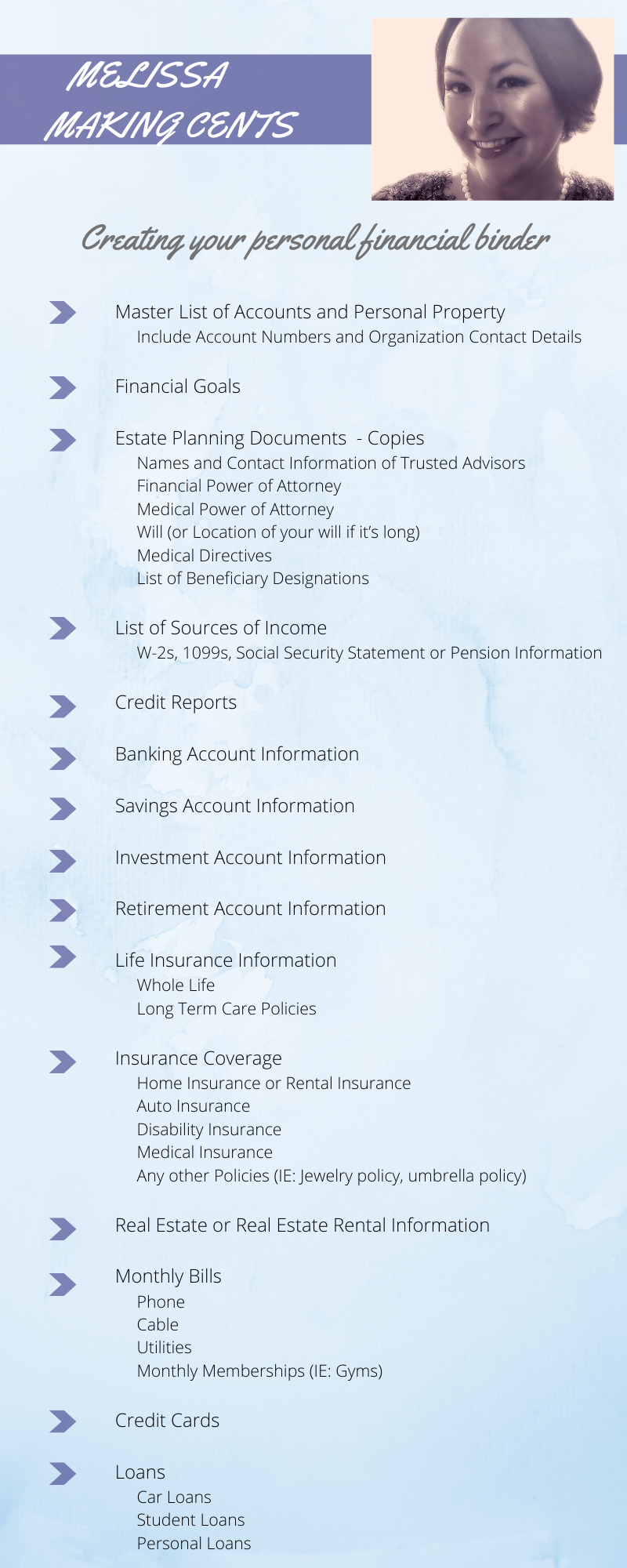
The Ultimate Guide to Creating a Personal Financial Binder | Get Organized
Introduction: Why Financial Organization Matters
Back in 2020, I wrote this article as a way to help my clients get financially organized during uncertain times. Little did I know it would become one of my most read and requested pieces over the years! It’s been a client favorite—and one of mine too—because it covers something I believe every household needs: a Personal Financial Binder.
As a Certified Financial Planner™ (CFP®), I’ve seen how disorganization creates stress, delays, and costly mistakes during times when families need clarity the most. That’s why I decided to give this article new life—and a permanent home—in my book Future-Focused Wealth. I truly believe this step-by-step system is essential for financial preparedness, legacy planning, and peace of mind.
Whether you're brand new to organizing your finances or want to finally tackle that stack of paperwork, this guide walks you through how to create a Personal Financial Binder that keeps your entire financial life accessible, up to date, and ready when you need it most.
Let me say this clearly—this step is that important. I believed in it so much, I dedicated an entire chapter to it in my book, Future-Focused Wealth. In those pages, I walk through why having your financial life organized, accessible, and ready for the unexpected isn’t just helpful—it’s foundational. Your financial future depends on your ability to manage and access key information when it matters most, and a well-structured binder makes that possible.
📌 Pro Tip: While digital storage is great, having a physical binder ensures immediate access when you need it most!
🔹 Want to dive deeper? Grab a copy of the book and go directly to Chapter 4!
Step 1: Gather Your Essential Financial Documents
Why It Matters:
Having all your financial information in one place makes managing your finances easier and ensures quick access in case of an emergency.
Action Steps:
✔️ Stop by your favorite office supply store and pick up:
- A Large 3 Ring Binder
- Plastic Pocket Sheets
Dividers
✔️ Collect important documents such as:
- Banking account statements
- Investment account details
- Insurance policies (life, health, disability, home, auto, etc.)
- Estate planning documents (will, power of attorney, medical directives)
- Tax returns and income records
- Real estate or rental property information
Loan details (student loans, car loans, mortgage, personal loans)
✔️ Make a list of account numbers, financial institutions, and key contacts.
✔️ Store physical copies in a secure binder and scan digital versions for added security.
📌 Pro Tip: Use a fireproof and waterproof document safe for added protection.
Step 2: Organize Your Binder by Category
Why It Matters:
A well-structured binder allows you to quickly find what you need when you need it.
Recommended Categories:
📂 Banking Information
📂 Investment Accounts
📂 Retirement & Pension Plans
📂 Insurance Policies (Life, Health, Disability, Auto, Home, etc.)
📂 Estate Planning & Legal Documents (Will, POA, Medical Directives, Beneficiary Designations)
📂 Real Estate & Mortgage Documents
📂 Monthly Bills & Service Provider Information
📂 Credit Card & Loan Information
📂 Tax Returns & Income Documentation
📂 Financial Goals & Net Worth Summary
📌 Pro Tip: Color-code sections for even faster access!
Step 3: Secure Your Personal Information
Why It Matters:
Protecting your financial information ensures your identity and assets are safe from fraud and unauthorized access.
Action Steps:
✔️ Use strong passwords for online financial accounts and enable two-factor authentication.
✔️ Store sensitive documents securely and limit access to trusted individuals.
✔️ Shred outdated financial documents instead of simply discarding them.
📌 Pro Tip: Consider using a password manager to securely store account logins.
🔹 External Source: How to Keep Your Personal Information Safe
Step 4: Review and Update Regularly
Why It Matters:
Financial situations change over time, and keeping your binder updated ensures your plan remains effective.
Action Steps:
✔️ Review your binder at least once a year or after major life changes (marriage, home purchase, job change).
✔️ Update beneficiary information as needed.
✔️ Remove outdated documents and replace them with current versions.
📌 Pro Tip: Set a reminder on your calendar to update your binder annually.
🔹 Related Read: Understanding Your Credit Report
Final Thoughts: Take Control of Your Financial Future
Organizing your financial life with a Personal Financial Binder isn’t just about convenience—it’s about financial empowerment. By following these five steps, you’ll create a valuable resource that helps you manage your money efficiently, prepare for the unexpected, and ensure that your loved ones are taken care of.
📚 Want a deeper dive into financial preparedness? My book, Future-Focused Wealth, dedicates an entire chapter to this concept, guiding you through the why and how of organizing your financial world. Grab your copy here!
📩 Want a free Financial Binder Checklist? Schedule a time to discuss your financial goals with Melissa Cox. 🚀
FAQs: Personal Financial Binder
1. What is a Personal Financial Binder?
A Personal Financial Binder is a well-organized collection of all your important financial documents, including banking, investments, insurance, estate plans, and tax records.
2. Who should have a Personal Financial Binder?
Everyone! Whether you’re single, married, retired, or running a business, having all your financial information in one place ensures you are prepared for any situation.
3. Should I keep physical or digital copies?
Ideally, both. Keep physical copies in a fireproof safe and store digital copies on a password-protected drive or cloud storage for easy access.
4. How often should I update my binder?
At least once a year or after major life changes such as a job switch, home purchase, marriage, or inheritance.
5. Should I share my binder with family members?
Yes, but only with trusted individuals such as a spouse, executor, or financial advisor.
6. Why is a physical binder important if I prefer digital?
Digital storage is great, but when you’re locked out of your account or need an urgent document, a physical binder ensures immediate access.






